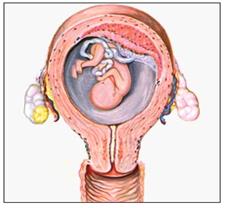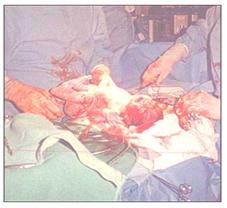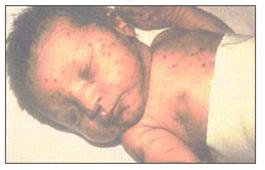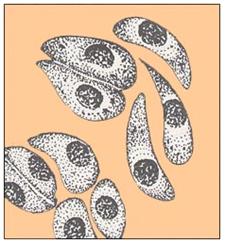토취(톨취), TORCH, 스톨취, STORCH 1/28/2022
1. 임신 중 태아가
- 톡소플라즈마 원충(Toxoplasma gondii),
- 매독균 등 병원체(Others such as syphilis),
- 풍진바이러스(Rubella virus),
- 사이토메갈로바이러스(Cytomegalovirus),
- 헤르페스바이러스(허피스바이러스/Herpes virus/Herpes simplex virus)에 감염되어 태아 감염병이 생길 수 있다.
- “TORCH”라는 병명은 위 5가지 병원체의 영어 첫째 알파벳 ‘T’ ‘O ‘R’, ‘C’, ‘H’ 자를 따라 만든 단어이다.
2. 임신 중 태아가
- 매독 Syphillis
- 톡소플라즈마 원충(Toxoplasma gondii),
- 매독균 등 병원체(Others infections such as variella zoster virus pavovirus B19),
- 풍진바이러스(Rubella virus),
- 사이토메갈로바이러스(Cytomegalovirus),
- 헤르페스 단순 바이러스(Herpes simplex virus)에 감염되어 태아 감염병이 생길 수 있다.
- “STORCH”라는 병명은 위 6가지 병원체의 영어 첫째 알파벳 ‘S’ ‘T’ ‘O ‘R’, ‘C’, ‘H’ 자를 따라 만든 단어이다.
1. 신생아 헤르페스바이러스성 감염병

그림 223. 임신 중 자궁 내 태아가 모체에서 2형 헤르페스바이러스에 감염되어 선천성 신생아 2형 헤르페스바이러스 감염병에 걸릴 수 있다. 그리고 임산부의 산도에서 2형 헤르페스바이러스에 감염되어 신생아가 2형 헤르페스바이러스 감염에 걸릴 수 있다.
출처-소아 가정의학백과와 “Illustrations from Pregnancy in Anatomical Illustrations apear courtesy of the copyright owner c Carnation Company, Los Angeles, CA 1962“

사진 224. 임신부의 산도나 외음부에 2형 헤르페스바이러스 감염병이 있으면 분만 중 아기에게 2형 헤르페스바이러스 감염이 생기지 않게 자연분만을 하는 대신 제왕절개 수술 분만하는 것이 보통이다.
Copyright ⓒ 2013 John Sangwon Lee, MD., FAAP
- 잠복기는 약 4 주이고 태어난 후 첫 며칠 동안 발생될 수 있다.
- 출생 전 태반이나 산도에서 감염될 수 있다.
- 드물게는 2형 헤르페스바이러스에 감염되어 있는 질 산도 속을 통해 태아어 나는 아기에게 감염될 수 있다.
■ 2형 헤르페스바이러스 감염병이 신생아에게 발생되면
- 헤르페스 바이러스가 전신으로 감염되어 중추신경뿐만 아니라 전신 신생아 2형 헤르페스바이러스 감염병이 생길 수 있다. 그래서 박테리아성 패혈증을 앓는 것같이 몹시 심하게 앓을 수 있다.
- 중추신경에만 한정되어 신생아 중추 신경 2형 헤르페스바이러스 감염병을 앓을 수도 있고, 어떤 병을 앓는지 확실히 모를 정도로 특이한 증상 징후가 나타나지 않을 수 있다. 그래서 이 병의 초기에는 확실히 진단 내릴 수 없는 경우도 있다.
- 열이 나고 보채고 예민한 증상 징후가 신생아에게 생기고 뇌척수액 검사의 결과가 비정상적이
- 고 특히 전신 경련을 하면 신생아 2형 헤르페스 바이러스 감염을 일단 의심해야 한다.
- 생아 2형 헤르페스 바이러스 감염병이 있으면 0.3%~1.0%에서 열이 나고 척수액 검사의 결과가 비정상적이다(Archies of pediatrics and adolescent medicine, July 2008, p.665).
- 피부, 눈, 입 등에 국한된 2형 헤르페스바이러스 감염을 앓을 수 있다.
- 2형 헤르페스바이러스 감염이 피부에 생기면 구릅으로 습포가 나고 어떤 수포에는 딱지가 지고, 또 어떤 습포에 궤양이 생기기도 한다.
- 2형 헤르페스바이러스 감염병으로 바이러스성 뇌염, 간염, 폐렴 등이 생길 수 있다.
- 병력, 증상 징후, 진찰 소견 등을 종합하고 쟁크 세포 검사(Tzanck cell test), 형광 항체검사, 바이러스 배양검사 등으로 진단한다.
신생아 2형 헤르페스바이러스성 뇌염은 병원에서
① 에이사이클로비아(acyclovir)
② Famciclovir(Famvir)
③ 또는 valacyclovir(Valtrex) 등 항바이러스제를 혈관주사로 치료 한다.
④ 때로는 비다라빈(Vidarabine) 항바이러스제를 혈관주사로도 치료한다. 그 중 에이사이클로비아 혈관주사 치료를 가장 많이 쓴다.[부모도 반의사가 되어야 한다–소아가정간호백과]-제 7권 소아 청소년 감염병 질환–헤르페스바이러스 감염 참고. 제 25권 임신, 분만, 출산, 신생아 돌보기–헤르페스바이러스감염 참고
2. 거대 세포 바이러스 감염병 Cytomegalovirus infection

사진 225. 거대 세포 바이러스의 감염을 예방하기위해 신생아를 격리시킨다.
Copyright ⓒ 2013 John Sangwon Lee, MD, FAAP
- 사이토메갈로바이러스(Cytomegalovirus)를
- 거대세포바이러스 또는 CMV라고 한다.
- 헐피스바이러스의 일종이다. 토취(TORCH) 일으킬 수 있는 병원체의 하나이다.
- 거대세포바이러스는 선천성 태아 바이러스성 감염병을 일으키는 가장 흔한 원인 중 하나이다.
- 출생 이후 40세가 될 때까지 50~85%가 이 바이러스에 감염되고 학령기 아이들의 25~60%가 이 바이러스를 보균하고 있다.
- 보균자의 침이나 소변, 또는 대변, 정액, 모유, 눈물, 자궁 경부 분비물, 질 분비물, 피, 수혈, 기관 이식 등을 통해 거대세포바이러스에 감염될 수 있고
- 사람과 사람 접촉, 분만 전, 분만 중, 분만 후 모체로부터 아기에게 감염될 수 있다.
- 거대세포바이러스,
- 헤르퍼스바이러스
- B형 간염바이러스,
- 풍진바이러스,
- 콕삭키바이러스,
- 톡소플라스마 원충
- 매독균
- 그 외 다른 병원체 감염으로 신생아 간염병이 생길 수 있고
- 그런 간염병으로 인해 신생아들에게 신생아 황달이 생길 수 있다.
- 임산부가 거대세포바이러스에 감염되면 태아가 그 바이러스에 감염될 수 있다. 이렇게 생긴 감염병을 선천성 거대세포 감염이라고 한다.
- 약 1%의 신생아에게서 선천성 거대세포바이러스 감염병이 발견되고 그 중 5%에서는 심한 선천성 거대세포바이러스 감염병의 증상 징후가 나타나고,
- 그 중 약 5%에서는 경증 선천성 거대세포바이러스 감염병의 증상 징후가 나타난다고 한다.
- 나머지는 잠복 감염으로 나타날 수 있다.
- 심한 선천성 거대세포바이러스 감염에 걸린 아기에게 귀머거리, 눈멀기, 지능장애, 간 비대, 비장비대, 소뇌증, 혈소판 감소, 비전형 림프구증, 맥락막 망막염, 출혈성 피부반점 등이 생길 수 있다.
- 증상 진단 진찰 등을 종합해 이 병이 의심하면, 소변, 피, 인두 점막, 백혈구, 모유, 점액, 그 외 체액, 타액 등에서 거대세포바이러스 배양 검출해서 확진할 수 있다.
- 임산부의 피를 검사해서 진단할 수 있다. 태아가 이 바이러스에 감염됐을 때는 양수검사로 진단할 수 있다.
- 거대세포바이러스 IgM, 효소 연결 면역 흡착 검사, 간접면역 형광법 등의 검사로 진단할 수 있다.
- 임신부가 거대세포바이러스에 감염되면 인두통, 피로, 열, 몸살 등의 증상이 생길 수 있다. 임신부의 거대세포바이러스의 감염을 치료하는 특효약은 없다.
- 거대세포바이러스 감염으로 생긴 망막염에는 Ganciclovir 항 바이러스제 치료가 효과 있다. 또 CMV 면역 글로불린과 Ganciclovir으로 치료하기도 한다.
- 평소에 손을 깨끗이 씻고 남의 소변이나 침 등 인체에서 분비되는 체액에 접촉되지 않게 주의해서 이 병을 예방한다. 부모도 반의사가 되어야 한다–소아가정간호백과]-제 25권 임신, 분만, 출산, 신생아 돌보기. 제 7권 소아 청소년 감염병–거대세포바이러스 참고.
3. 선천성 풍진 증후군 Congenital rubella syndrome

사진 226.선천성 풍진 증후군
참조문헌-CDC, USA
■ 원인
- 풍진 백신으로 과거에 한 번도 예방접종을 받지 않았거나 풍진을 한 번도 앓은 적이 없어 풍진바이러스 감염에 면역이 없는 임신부가 임신 제1 삼개월기 중 풍진을 앓을 때 태아에게 풍진 바이러스 감염이 생겨 태아 풍진이 생길 수 있다.
- [부모도 반의사가 되어야 한다– 소아가정간호백과]-제 2권 소아청소년 질병 및 안전사고 예방–풍진 예방접종,
- 제 7권 소아청소년 감염병,
- 제 25권 임신분만과 신생아 돌보기까지–풍진 참조.
- 태아가 자궁 내에서 풍진에 걸리면 특히 임신 제1 삼개월기 중 여러 종류의 선천성 기형이 태아에게 생길 수 있다. 이런 선천성 태아 풍진을 선천성 풍진 증후군이라 한다.
- 선천성 풍진 증후군이 있으면 신생아에게
- 농아,
- 백내장,
- 소두증,
- 심장 선천성 기형 등 여러 가지 선천성 기형이 생길 수 있다.
■ 선천성 풍진 증후군의 증상 징후
- 선천성 풍진 증후군의 증상 징후는 다양하고 전형적인 증상 징후는 다음과 같다.
- 심한 선천성 풍진 증후군에 걸린 태아의 성장 발육이 지연되고 낙태되거나 유산이 될 수 있다.
- 선천성 풍진 증후군에 걸린 태아가 출생하면 신생아의 눈이 멀거나, 귀가 먹기도 하고, 심장 기형이 생길 수 있다.
- 태어난 후 그 외 여러 종류의 선천성 기형이 신생아에게 생길 수 있고 혈소판 감소증도 생길 수 있다.
- 신생아의 간, 지라, 림프절 등이 부을 수 있다.
- 그 외 소두증, 성장 발육 지연, 지능저하, 학습 장애 등의 증상 징후도 생길 수 있다.
■ 선천성 풍진 증후군의 진단
- 병력, 증상 징후, 진찰소견 등을 종합해서 진단할 수 있다.
- 임신 제1 3개월기 동안 임신부가 풍진을 앓은 경험이 있으면 선천성 풍진 증후군을 진단하는데 아주 중요한 단서가 될 수 있다.
- 신생아의 인두 점액, 소변, 뇌 척수액 등에서 얻은 피검 물로 풍진 바이러스를 배양해서 확진할 수 있다.
- 혈 중 풍진바이러스 항원, 항체 검사로 진단 한다.
■ 선천성 풍진 증후군의 치료
- 선천성 풍진증후군의 치료하는 특효약도 없고 특별한 치료도 없다.
- 여러 가지 선천성 기형으로 인한 증상 징후에 따라 대증치료를 한다.
- 제 7 권 선천성 풍진증후군 참조
4. 선천성 톡소플라스마증 Congenital toxoplasmosis in newborn infants

그림 5-19. 톡소플라스마 원충 그림
출처: Medical Microbiology, Ernest jawetz, Hoseph L. Melnick, Edward A. Adelberg

그림 5-20. 임신 중 고양이나 개를 특히 조심해야 한다.
Copyright ⓒ 2013 John Sangwon Lee, MD.FAAP
- 톡소플라스마 곤디이(Toxoplasma gondii)는 일종의 원충(Protozoa)이다.
- 이 원충에 감염되어 생기는 감염병을 톡소플라스마증이라 한다.
- 출생 전 태아에게 감염되어 생긴 톡소플라스마증을 선천성 톡소플라스마증이라 한다.
- 임신부가 이 원충에 오염된 육류 고기를 익히지 않고 먹거나 잘 요리되지 않은 채 먹거나 이 원충에 오염된 과일 또는 채소를 잘 씻지 않은 채로 먹거나 오염된 흙에 접촉되면 이병에 걸릴 수 있다.
- 이 원충을 보균한 고양이의 똥을 만질 때 이 병원체에 감염될 수 있고 태아가 이 원충에 감염된 후 태아 톡소플라스마증에 걸릴 수 있고 이 병을 가지고 태어난 신생아에게 여러 가지 증상 징후가 생길 수 있다(p.00 톡소플라스마증 참조).
- 미국 신생아의 12,000명 중 1명에게 선천성 톡소플라스마증이 발생되지만 산전 건강관리를 받지 않거나 채소, 과일, 육류 고기 등을 먹는 습관에 따라 발병률이 다르다.
- 동남아 임신부들에게 태어난 신생아들에게 더 많이 발생된다.
- IgG 항체, IgM 항체 검사로 진단할 수 있다.
- Pyrimethamine and sulfadiazine 으로 치료한다(p.00 참조).[부모도 반의사가 되어야 한다–소아가정간호백과]-제 12권 소아청소년 심혈관 질환–선천성 심장질환, 제 25권 임신, 분만, 신생아 돌보기–임신과 톡소플라스모시스증 참조.
5. 선천성 매독(선천 매독) Congenital syphillis
- 다음과 같은 경우에 선천성 매독이 생길 수 있다.
- 매독의 증상 징후가 조금도 나타나지 않아 매독에 걸려 있는지도 모르고 있던 임신부로부터 매독균이 태아에게 감염되어 그 임신부에게 태어난 아기에게 선천성 매독이 생길 수 있고,
- 매독균을 보균한 임신부는 태아에게 매독균을 감염시킬 수 있다.
- 모체로부터 매독균에 감염된 태아가 태어난 후에 선천성 매독을 앓을 수 있다.
- 임신 중 매독을 앓고 있는 임신부로부터 매독균이 태아에게 감염되어 태아가 선천성 매독에 걸릴 수 있다.
- 이렇게 태아가 모체로부터 매독에 걸린 후 태어난 아기들의 매독을 적절히 치료하지 않는 한 출생 후 선천성 매독을 계속 앓게 된다.
Torch
TORCH fetus during pregnancy
1. Toxoplasma gondii,
2. Others such as syphilis;
3. Rubella virus,
4. Cytomegalovirus,
5. Infection with herpes virus (Herpes virus/Herpes simplex virus) can cause fetal infectious disease.
• The disease name “TORCH” is a word created after the first letters of the English letters ‘T’, ‘O’, ‘R’, ‘C’, and ‘H’ of the above five pathogens.
1. Neonatal herpesvirus infection

Figure 223. A fetus in utero during pregnancy can become infected with the herpes virus type 2 in the mother and contract the congenital neonatal type 2 herpes virus infection. In addition, the birth canal of a pregnant woman is infected with the herpes virus type 2, and the newborn can contract the type 2 herpes virus infection.
Source: Pediatric Family Medicine Encyclopedia and “Illustrations from Pregnancy in Anatomical Illustrations apear courtesy of the copyright owner c Carnation Company, Los Angeles, CA 1962“

Photo 224. If a pregnant woman has a type 2 herpesvirus infection in the birth canal or vulva, it is common to have a cesarean section instead of a vaginal birth to prevent herpes virus infection in the baby during labor. Copyright ⓒ 2013 John Sangwon Lee, MD., FAAP
• The incubation period is about 4 weeks and can occur during the first few days after birth.
• Can be transmitted in the placenta or birth canal before birth.
• Rarely, it can be transmitted to an unborn baby through the vaginal acid canal that is infected with the herpes virus type 2 virus.
■ When a type 2 herpesvirus infection occurs in a newborn
• Herpes virus can infect the whole body and cause systemic neonatal type 2 herpesvirus infection as well as the central nervous system. So it can be as bad as bacterial sepsis.
• Newborns may suffer from central nervous system herpesvirus type 2 infection that is limited to the central nervous system, and they may not show specific symptoms to the extent that they do not know for sure what disease they have. Therefore, in the early stages of the disease, it may not be possible to make a definitive diagnosis.
• Fever, flushing, and sensitive signs of symptoms in newborns and abnormal cerebrospinal fluid test results.
• If you have high and especially generalized convulsions, you should first suspect a neonatal type 2 herpesvirus infection.
• Fever occurs in 0.3% to 1.0% of live infants with herpesvirus type 2 infection and the results of spinal fluid examination are abnormal (Archies of pediatrics and adolescent medicine, July 2008, p.665).
• You may have a type 2 herpesvirus infection that is localized to your skin, eyes, or mouth.
• Herpes 2 virus infection on the skin causes pustules on the rolls, some blisters scab, and some blisters.
• Type 2 herpesvirus infection can cause viral encephalitis, hepatitis, and pneumonia.
• The medical history, symptom signs, and examination findings are synthesized, and diagnosis is made by Tzanck cell test, fluorescent antibody test, and virus culture test. Neonatal herpesvirus type 2 encephalitis
① acyclovir
② Famciclovir (Famvir)
③ Alternatively, an antiviral drug such as valacyclovir (Valtrex) is administered by intravenous injection.
④ Sometimes, Vidarabine antiviral is also treated by intravenous injection. Among them, acyclovia vascular injection is the most commonly used treatment.
www.drlee]-Vol. See Volume 25, Pregnancy, Childbirth, Childbirth, and Newborn Care-Herpes Virus Infection.
2. Cytomegalovirus infection

Picture 225. Isolation of newborns to prevent infection with cytomegalovirus. Copyright ⓒ 2013 John Sangwon Lee, MD, FAAP
• Cytomegalovirus
• It is called cytomegalovirus or CMV.
• It is a type of herpesvirus. It is one of the pathogens that can cause TORCH.
• Cytomegalovirus is one of the most common causes of congenital fetal viral infections.
• From birth to 40 years of age, 50-85% are infected with the virus and 25-60% of school-age children carry the virus.
• The cytomegalovirus can be transmitted through the saliva or urine of a carrier or through feces, semen, breast milk, tears, cervical secretions, vaginal secretions, blood, blood transfusions, organ transplants, etc.
• Human-to-human contact, before delivery, during delivery, and after delivery, can be transmitted from mother to baby.
• cytomegalovirus;
• herpes virus
• Hepatitis B virus;
• rubella virus;
• Coxsackie Virus;
• Toxoplasma protozoa
• Syphilis
• Other pathogenic infections can cause neonatal hepatitis and
• Such hepatitis can cause neonatal jaundice in newborns.
• If a pregnant woman is infected with a cytomegalovirus, the fetus can become infected with the virus. This type of infectious disease is called congenital giant cell infection.
• About 1% of newborns have a congenital cytomegalovirus infection, and 5% of them show symptoms of severe congenital cytomegalovirus infection;
• About 5% of them show symptoms of mild congenital cytomegalovirus infection.
• The rest may appear as latent infections.
• Babies with severe congenital cytomegalovirus infection can develop deafness, blindness, intellectual disability, hepatomegaly, splenomegaly, cerebellum, thrombocytopenia, atypical lymphocytosis, choroidal retinitis, and hemorrhagic skin spots. • If this disease is suspected by combining symptom diagnosis and examination, it can be confirmed by detecting cytomegalovirus culture in urine, blood, pharyngeal mucosa, white blood cells, breast milk, mucus, other body fluids, and saliva.
• Diagnosis can be made by testing the blood of pregnant women. When a fetus is infected with this virus, it can be diagnosed by amniocentesis.
• Diagnosis can be made by tests such as cytomegalovirus IgM, enzyme-linked immunosorbent test, and indirect immunofluorescence.
• If a pregnant woman is infected with cytomegalovirus, symptoms such as sore throat, fatigue, fever, and body aches may occur. There is no specific drug to treat cytomegalovirus infection in pregnant women.
• Ganciclovir antiviral treatment is effective for retinitis caused by cytomegalovirus infection. It is also treated with CMV immunoglobulin and Ganciclovir.
• Prevent this disease by washing your hands regularly and being careful not to come into contact with other body fluids such as urine or saliva.www.drleepediatrics.com – Vol. 25 Pregnancy, childbirth, childbirth, and caring for newborns. See Volume 7, Infectious Diseases in Children and Adolescents – Cytomegalovirus.
3. Congenital rubella syndrome

Picture 226. Congenital rubella syndrome References – CDC, USA
■ Cause
• When a pregnant woman who is not immune to rubella virus infection because she has never been vaccinated with rubella vaccine or has never had rubella, her fetus becomes infected with rubella virus during the first trimester of pregnancy, resulting in fetal rubella. this can happen
www.drleepediatrics.com] – Volume 2 Prevention of Diseases and Safety Accidents in Children and Adolescents – Rubella Vaccination,
• Volume 7 Infectious Diseases in Children and Adolescents,
• See Volume 25, From Pregnancy to Newborn Care—Rubella.
• If the fetus gets rubella in utero, several types of birth defects can occur in the fetus, especially during the first trimester of pregnancy. This congenital fetal rubella syndrome is called congenital rubella syndrome.
• Newborns with congenital rubella syndrome
• Deaf;
• Cataract,
• microcephaly;
• Various congenital anomalies such as congenital anomalies of the heart may occur.
■ Symptoms, signs of Congenital Rubella Syndrome
• Symptoms of congenital rubella syndrome are diverse, and typical symptoms are as follows.
• A fetus with severe congenital rubella syndrome may be stunted in growth and development and may have abortions or miscarriages.
• The birth of a fetus with congenital rubella syndrome can cause the newborn to be blind, deaf, and have heart defects.
• After birth, several other congenital anomalies may occur in newborns and thrombocytopenia may occur.
• The newborn’s liver, spleen, and lymph nodes may swell.
Other symptoms such as microcephaly, growth retardation, intellectual decline, and learning difficulties may also occur.
■ Diagnosis of congenital rubella syndrome
• Diagnosis can be made by combining medical history, symptoms, and examination findings.
• Experience of a pregnant woman with rubella during the first trimester of pregnancy can be a very important clue in diagnosing congenital rubella syndrome.
• Diagnosis can be confirmed by culturing rubella virus with specimens obtained from newborn pharyngeal mucus, urine, and cerebrospinal fluid.
• Diagnosis is made by blood rubella virus antigen and antibody test.
■ Treatment of congenital rubella syndrome
• There is no specific drug and no specific treatment for congenital rubella syndrome.
• Symptomatic treatment according to the symptoms of various congenital anomalies. • See Volume 7 Congenital Rubella Syndrome.
4. Congenital toxoplasmosis in newborn infants

Figure 5-19. Toxoplasma protozoa illustration Source: Medical Microbiology, Ernest jawetz, Hoseph L. Melnick, Edward A. Adelberg

Figure 5-20. Be especially careful with cats and dogs during pregnancy. Copyright ⓒ 2013 John Sangwon Lee, MD.FAAP
• Toxoplasma gondii is a kind of Protozoa.
• An infectious disease caused by infection with this protozoa is called toxoplasmosis.
• Toxoplasmosis caused by infection with a fetus before birth is called congenital toxoplasmosis.
• Pregnant women can contract this disease if they eat uncooked or uncooked meat contaminated with this parasite, eat uncooked fruits or vegetables contaminated with this parasite, or come into contact with contaminated soil.
• You can become infected with this pathogen when you touch the poop of a cat that carries this protozoa, your fetus can get fetal toxoplasmosis after being infected with this protozoa, and a number of signs and symptoms can develop in newborns born with the disease ( see toxoplasmosis).
• Although 1 in 12,000 newborns in the United States develop congenital toxoplasmosis, the incidence varies depending on lack of prenatal health care or eating habits such as vegetables, fruits, and meat.
• It is more common in newborns born to pregnant women in Southeast Asia.
• Diagnosis can be made by testing for IgG antibody and IgM antibody.
• Treat with pyrimethamine and sulfadiazine. See Pregnancy and Toxoplasmosis.
5. Congenital syphilis Congenital syphillis
• Congenital syphilis can occur in the following cases.
• A pregnant woman who did not know she had syphilis because she showed no symptoms of syphilis could infect her fetus with syphilis bacteria and develop congenital syphilis in her baby;
• Pregnant women who carry syphilis can infect their fetus with syphilis.
• A fetus infected with syphilis from the mother may develop congenital syphilis after birth. • Syphilis bacteria from a pregnant woman suffering from syphilis during pregnancy can infect the fetus and cause the fetus to develop congenital syphilis.
• Babies born after this maternal syphilis contract will continue to develop congenital syphilis after birth unless syphilis is properly treated.
Update, Source, 1/2022, Pediatrics
- 임신 중 태아가
- 매독 Syphilis
- 톡소플라즈마 원충 감염병(Toxoplasmosis),
- 매독균 등 병원체(Others infections such as Varicella zoster virus parvovirus B19),
- 풍진바이러스(Rubella virus),
- 사이토메갈로바이러스(Cytomegalovirus),
- 헤르페스 단순 바이러스(Herpes simplex virus)에 감염되어 태아 감염병이 생길 수 있다.
- “STORCH”라는 병명은 위 6가지 병원체의 영어 첫째 알파벳 ‘S’ ‘T’ ‘O ‘R’, ‘C’, ‘H’ 자를 따라 만든 단어이다.
- The fetus during pregnancy
- Syphilis 2. Toxoplasmosis,
3. Others infections such as Varicella zoster virus, parvovirus B19; 4. Rubella virus, 5. Cytomegalovirus, 6. Infection with herpes simplex virus can cause fetal infectious disease.
The disease name “STORCH” is a word created by following the letters ‘S’ ‘T’, ‘O ‘R’, ‘C’, and ‘H’ of the above six pathogens.
출처와 참조 문헌 Sources and references
- NelsonTextbook of Pediatrics 22ND Ed
- The Harriet Lane Handbook 22ND Ed
- Growth and development of the children
- Red Book 32nd Ed 2021-2024
- Neonatal Resuscitation, American Academy Pediatrics
-
소아가정간호백과–부모도 반의사가 되어야 한다, 이상원 저
-
Nelson Textbook of Pediatrics 14th ed. Beherman,
-
The Johns Hopkins Hospital, The Harriet Lane Handbook, 18th edition
-
Red book 29th edition 2012
-
Nelson Text Book of Pediatrics 19th Edition
-
Infectious disease of children, Saul Krugman, Samuel L Katz, Ann A. Gershon, Catherine Wilfert
-
The Harriet Lane Handbook 19th Edition
-
제12권 소아청소년 신경 정신 정서 심리 행동 잠 문제 참조문헌 및 출처
-
Congenital Heart Disease Pediatric Clinics of North America 1990
-
Sources and references on Growth, Development, Cares and Diseases of Newborn Infants
-
Emergency Medical Service for Children, By Ross Lab. May 1989. p.10
-
Emergency care, Harvey grant and Robert Murray
-
Emergency Care Transportation of Sick and Injured American Academy of Orthopaedic Surgeons
-
Emergency Pediatrics A Guide to Ambulatory Care, Roger M. Barkin, Peter Rosen
-
Quick Reference To Pediatric Emergencies, Delmer J. Pascoe, M.D., Moses Grossman, M.D. with 26 contributors
-
Neurology in Pediatrics, P. F. Bray, Yearbook Medical Publishers
-
Behavior Disorders in Children, Bakwin and Bakwin
-
How to love really love child, Ross Campbell
-
Guide to your child’s sleep George Cohen, MD.
-
Growth and Development of Children, George H. Lowrey 8th edition
-
소아과학 대한교과서
-
의학 용어사전 대한 의사 협회
-
그 외
Copyright ⓒ 2014 John Sangwon Lee, MD., FAAP
“부모도 반의사가 되어야 한다”-내용은 여러분들의 의사로부터 얻은 정보와 진료를 대신할 수 없습니다.
“The information contained in this publication should not be used as a substitute for the medical care and advice of your doctor. There may be variations in treatment that your doctor may recommend based on individual facts and circumstances.
“Parental education is the best medicine